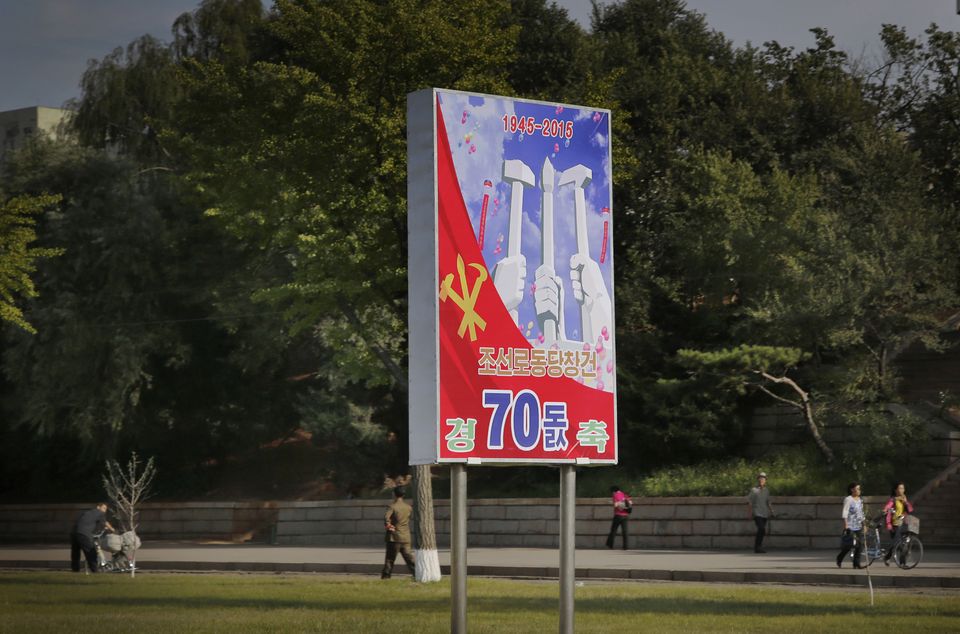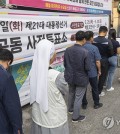- California Assembly OKs highest minimum wage in nation
- S. Korea unveils first graphic cigarette warnings
- US joins with South Korea, Japan in bid to deter North Korea
- LPGA golfer Chun In-gee finally back in action
- S. Korea won’t be top seed in final World Cup qualification round
- US men’s soccer misses 2nd straight Olympics
- US back on track in qualifying with 4-0 win over Guatemala
- High-intensity workout injuries spawn cottage industry
- CDC expands range of Zika mosquitoes into parts of Northeast
- Who knew? ‘The Walking Dead’ is helping families connect
As N. Korea readies grand parade, hunger and clean water still issues

In this Sept. 15, 2015, photo, people walk past a sign board marking the upcoming 70th anniversary of the founding of North Korea’s Workers’ Party in Pyongyang, North Korea. While North Korea prepares a big show to mark the 70th anniversary of the ruling Workers’ Party, the daily struggles of life outside the capital – such as finding clean running water and putting nutritious food on the table year-round – pose a harsh, but largely unseen, contrast to the grand celebrations the world will see Oct. 10. (AP Photo/Wong Maye-E)
PYONGYANG, North Korea (AP) — While North Korea prepares a big show to mark the 70th anniversary of the ruling Workers’ Party, the daily struggles of life outside the capital – such as finding clean running water and putting nutritious food on the table year-round – pose a harsh, but largely unseen, contrast to the grand celebrations the world will see Oct. 10.
North Korea’s anniversary spectacle promises to be world-class. Masses of citizens will be mobilized to march, chant and hold up placards on cue to create huge images praising the party and leader Kim Jong Un. To make sure Pyongyang looks its best, extensive construction projects have considerably prettied up the capital, which is far and away the most developed city in North Korea and is even relatively comfortable for the increasingly affluent segment of its populace.
But life in the provinces, and particularly in rural areas, is quite a different story.
Ahead of the arrival of the hordes of visitors, dignitaries and foreign journalists who are now beginning to descend on Pyongyang for the celebrations, an Associated Press Television News crew was allowed to join the Red Cross on a visit to one of those communities in Sinyang County, which is just 150 kilometers (100 miles) from Pyongyang but takes three hours to reach by car on mostly unpaved roads.
Instead of the new high-rise apartments and bicycle lanes that have been put up in Pyongyang for the party anniversary, the people there are now just beginning to enjoy a far more fundamental improvement in their lives – disease-free running water.
The area is still recovering from serious flooding and landslides from 2006 to 2013 that caused many deaths and destroyed homes and basic infrastructure – roads, bridges and the water distribution system.
Seeing a dire need, the Red Cross got involved in 2013 with projects to re-establish a clean water system for 10,000 people in Sinyang and small-scale food processing facilities, which help people to make the most of what they can grow and reduce the amount of time and labor they used to have put in to get the food to the table.
Simple greenhouses set up with Red Cross support mean the local community can now produce vegetables all year round. Though hunger is uncommon in Pyongyang, where the population is far better off than elsewhere, the only vegetable available in winter to many people in the country’s hardscrabble rural areas is pickled kimchi.
“People’s hygiene and awareness has improved and the most important thing is that water-borne disease has been reduced,” said local Red Cross chairman Ri Won U. “Before it used be 35 percent of disease cases, now it’s less than 5 percent.”
Chris Staines, the head of the International Red Cross in Pyongyang, said Red Cross projects aim to help people in the simplest and most effective ways – which he said is crucial in places like Sinyang because of the area’s cold and harsh winters.
But even with the Red Cross support, a great deal of work remains to be done. The population of Sinyang County is 58,000, but just 15,000 have benefited from the Red Cross efforts so far.
At the end of the trip to Sinyang, the Red Cross – which is hoping to expand its projects further – visited one of the areas where its help has not yet arrived. There, an old woman sat outside her home scraping corn off recently harvested cobs. The dry corn will be ground into flour to make food.
In the North Korean countryside, this is a common sight. Everything must be done by hand, from the fields to the home.
In Pyongyang, meanwhile, residents have been spending much of their time over the past few months practicing their mass routines, which will likely culminate in a torchlight event on Pyongyang’s Kim Il Sung Square.
And though the city was lit brightly Tuesday night, Pyongyang’s residents have also had to make some sacrifices. In the run-up to the anniversary, power for civilian use, always a scarce commodity in the North, had been diverted to priority, anniversary-related projects.
Further hinting at what’s in store come Saturday – and at North Korea’s political priorities – fighter jets blazed through the skies of the capital Tuesday in preparation for what is expected to be a major military parade on the morning of the anniversary day.
Based on North Korean rhetoric in recent weeks, analysts had thought there was a possibility of a more provocative display: a rocket launch, aimed at placing a satellite in orbit, that the U.N. and U.S. would consider an illegal test of long-range missile technology. U.S. observers and the South Korean defense ministry, however, now view a pre-anniversary launch as unlikely.
















